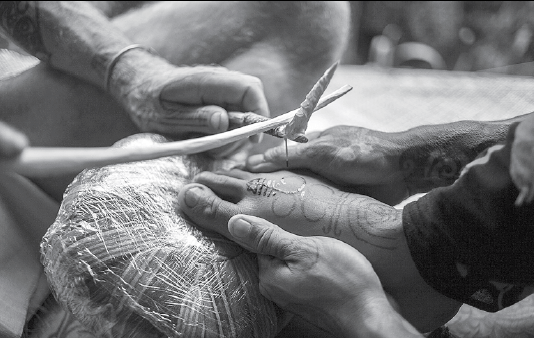 |
|
A tattoo artist uses the traditional hand tapping method. [Photo/Agencies] |
'Defend traditional culture'
In the capital Jakarta, a small museum dedicated to indigenous body art has opened, housed in a ramshackle building filled with tribal paraphernalia and photos of tattooed indigenous people.
"Hand-tapping" regularly takes place at the museum, whose name "Bau Tanah" refers to the musty smell that emanates from the earth after heavy rains.
At a recent "hand-tapping" session, tattoo artist Ranu Khodir knelt down and applied the image of a dragon in Dayak style on the stomach of Saman, a motorbike taxi driver, who like many Indonesians goes by one name.
An assistant stretched out Saman's skin, as he stayed stoically silent as the tattoo was applied.
Khodir, who is not from an indigenous group but looks every bit like the tribesmen whose work he reveres, with a wild mane of jet-black hair and motifs of stars and flowers covering his back, used to do machine tattooing but switched to "hand-tapping" a few years ago.
"I want to defend traditional Indonesian culture," he says.
There are downsides to the traditional methods-it takes many more hours for a tattoo to be applied by "hand-tapping" than with a machine.
Still, the old methods have been adapted for the modern world, with tattoo artists nowadays using sterilized needles and a light anaesthetic to dull the pain. In the past in tribal areas, tattoos were applied with fish bones or long thorns.
Despite signs of a revival in some areas, experts warn that tattooing styles of tribes in more remote places could be forgotten.
"I fear this ancient traditional and artistic knowledge will soon be lost forever unless a concerted effort is made to record it immediately," says Krutak.
|
|
|
|
|
|
|
|
